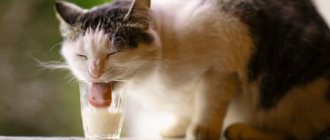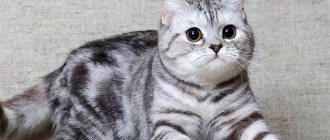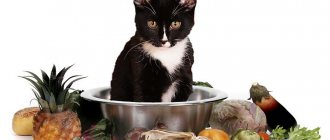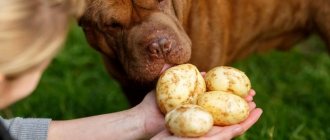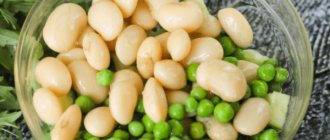Nutritional features of kittens
To answer the question whether a kitten can be given milk, you need to understand how its digestion works. From a scientific point of view, cats fall into the following categories:
- Class: Mammals;
- Squad: Predatory;
- Family: Felines.
Nature has provided that the best nutrition for a newborn kitten is its mother's milk. A mother cat, like a true mammal, feeds her babies with milk for up to 3 months. During this time, a special enzyme, lactase, is produced in the kittens’ small intestine, which allows them to digest lactose (milk sugar).
When the kitten is 1 month old, the mother begins to gradually introduce him to solid food. They try meat, but breastfeeding does not stop. We must not forget: cats are predators. The kitten's body is growing and preparing for adulthood. Instead of lactase, proteases begin to be produced - enzymes responsible for the breakdown of proteins.
By 3 months, the cat has finished breastfeeding the kitten, and it can be given meat food. Lactase is no longer produced because there is no need for milk.
Note: in very rare cases, the gastrointestinal tract of adult animals may retain the ability to produce small amounts of lactase and digest milk.
Which dairy products are not harmful?
Our purrs drink milk with pleasure, and rarely do any of them refuse such a delicacy. However, if your cat feels unwell after eating it, then you should not immediately categorically exclude absolutely all dairy products from its diet. Very often in such cases they give a little cottage cheese, fermented baked milk, and fermented milk products.
You should not treat your fluffy with sweet cheeses or yoghurts. The animal’s stomach will definitely not be able to accept such food and this will be a real blow to the pancreas.
It turns out that fermented milk products are best absorbed, but it is better to exclude sour cream altogether. If you want to give it to a cat, then dilute it in a 1:1 ratio with water, since it is too fatty. Of the cheeses, you can only have Adyghe cheese, and also in small quantities. The rest of the products are too fatty and salty and will harm the animal.
Something else interesting: Cat food brands
How to tell if your cat is lactose intolerant
The main symptoms of lactase deficiency in cats are painful bloating, diarrhea and vomiting. Most often, unpleasant symptoms appear 8-12 hours after the animal consumes milk.
The following mechanism works in the cat’s body: she drinks milk, but lactose is not broken down by lactase and passes through the small intestine undigested. Next, milk sugar attracts water and ends up in the large intestine, where bacteria try to process it. At this time, carbon dioxide, hydrogen and other substances that cause fermentation are released.
Is it possible to give cow's milk to a kitten?
When thinking about whether to treat your kitten to milk, you should clearly understand that the composition of cow's milk is significantly different from cat's milk. It is cat's milk that contains the optimal amount of nutrients for the full development of the baby.
So, cat's milk consists of 8% protein, and cow's milk - 3.5%. The fat content of the former is also higher on average - 4.5% versus 3.3%. And this is not to mention vitamins and minerals.
The problem with milk from the store is its quality.
- When raising cows, antibiotics are used, which then end up in the milk and can lead to dysbacteriosis.
- If the milk comes from a pregnant cow, it will have a higher estrogen content, which can cause hormonal imbalance in the kitten.
- The plants that the animal ate may have been treated with pesticides. Standards for toxic substances are calculated for people, but not for tiny kittens.
- Store-bought milk is pasteurized, which reduces its nutritional value.
- In addition, cow's milk protein is a strong allergen.
Giving cow's milk to a kitten can be downright dangerous!
What are the disadvantages of cow's milk and is it possible to give goat's milk?
It happens that for some reason a cat cannot feed a kitten. The best option would be to find a nursing cat who will always feed someone else's cub. If this is not possible, you should not run to the store for dairy products.
One of the disadvantages of cow's milk is that compared to cat's milk, it is less nutritious. In addition, it does not contain useful substances in the amount in which cats need them for full development. A comparison of nutrients is shown in the table:
| Protein (%) | Fat (%) | Water (%) | Calorie content (kcal) | |
| cat milk | 7-9 | 4,5 | 82 | 930 |
| Cow's milk | 3,5 | 3,3 | 87 | 720 |
Another (main) disadvantage is that milk from the store contains substances harmful to the kitten:
- antibiotics that are administered to cows when kept on farms;
- female hormone estrogen - if the cow was pregnant during the milking period;
- pesticides that remain on plants fed to cows;
- cow's milk protein is foreign to animals and can cause severe allergies;
- Store-bought dairy products are pasteurized, after which the content of nutrients and nutrients is reduced.
Goat's milk is better in composition than cow's milk. The amount of vitamins in it is several times greater. The fat and protein of goat's milk are easier to digest. In addition, it is low-allergenic. In some cases, it is allowed to feed the cubs with it, but it is advisable to dilute it with a small amount of water.
Goat and sheep milk
It must be admitted that goat and sheep milk is less allergenic than cow milk. If an adult cat has an intolerance to cow's milk, but you really want to treat it with milk, then this will be a good replacement.
As for kittens, ruminant milk does not cover their nutritional needs. Proteins and fats will not be enough, and, as a result, a kitten fed with goat's or sheep's milk will grow and develop slowly.
The lactose content in the milk of goats and sheep is higher than that of cats. Although kittens produce lactase, it is designed for cat milk.
Composition of cat milk
Cat milk contains all vitamins, microelements, amino acids, minerals, taurine, omega-3 and omega-6 fatty acids, as well as water, proteins, and lactose. The ratio of these substances varies significantly among different animals.
- Water content
Cat litter: which options are best to choose
Cat milk is 70% water. In the first days of life, kittens can only suck liquid milk. It is easily digestible and protects the health of babies.
- Protein content
Cat breast milk is rich in proteins. Their content is 11.1%.
For reference! The level of proteins surpasses even the milk of polar bears and dolphins.
- Lactose content
The lactose level in cat milk is about 3.4%. This is lower than other animals. This is why cow's milk is not suitable for cats: it contains more lactose, and this negatively affects the health of newborn kittens.
Cat's milk is high in fat and protein, but low in lactose.
Is it possible to give milk to a fold-eared kitten?
A real “urban legend” associated with milk concerns British and Scottish fold kittens. It goes like this: if you feed lop-eared kittens with cow's milk, their ears may “stand up.” The main argument in favor of this theory is that kittens will receive a lot of calcium from milk, which will strengthen the cartilage and straighten their ears.
This myth is used by unscrupulous breeders. In fact, Scottish and British kittens' ears may rise as they grow. This is due to a defect in the breed, or it can be considered a feature of a particular animal. Fallow cats must receive calcium and other minerals.
The answer to the question whether it is possible to give milk to a fold-eared kitten will be the same as for other breeds - cat milk is ideal, but cow, goat and sheep milk is not recommended.
Which cat milk replacer should you choose?
Since it is almost impossible to replace mother cat’s milk with natural analogues, many manufacturers of cat food and pet supplies offer their own analogues of mother’s milk. Powdered milk for kittens has a number of advantages over mixtures that can be prepared at home. Such nutrition is more balanced, since when creating it, manufacturers take into account the kittens’ needs for essential vitamins, minerals, amino acids and other microelements.
Such mixtures also include fatty acids such as Omega-6 and Omega-3, which have a good effect on the metabolism of kittens, which in turn stimulates the proper development of the growing body and the formation of reliable immunity.
There is an opinion that for different breeds of cats it is necessary to select different substitutes. In fact, this opinion is erroneous. Powdered milk for kittens is universal. The only difference is the dosage that needs to be fed to the kitten, and it depends on the weight of the animal, and not on the breed.
© shutterstock
There are quite a few manufacturers of milk powder for kittens. Their products differ in both price and composition. The highest quality products are from the following manufacturers :
- Royal Canin (Babycat Milk);
- Nutri-Vet;
- Hartz;
- Vo-Toys;
The powdered milk of these producers contains all the components necessary for the proper development of kittens.
How to feed a kitten
There are life situations when a kitten loses its mother too early, or she cannot feed him. In this case, the best solution would be to feed him a special mixture - a cat's milk replacer. Cat food manufacturers offer mixtures whose composition is as close as possible to cat milk. The food should be diluted with water, according to the instructions, and the baby should be fed using a special nipple (at an angle of 45 degrees). As a last resort, you can use a syringe without a needle or a pipette.
For the first 21 days of life, feed the kitten every 2-3 hours, but do not force it to eat more than it wants. Cats about a month old are fed 4 times a day. Two meals are formula, the other two are wet food.
If for some reason you can’t buy a cat’s milk substitute, you can feed the kitten with baby food. Choose formulas for very young children and dilute them with more water than the rules written on the label.
In a critical situation, dilute goat's milk with water - it is preferable to cow's milk.
If the kitten is older than 3 months, it no longer needs to be fed and does not need to be given milk.
Dosage when feeding kittens with milk replacers
The finished mixture must be measured correctly; for this, for example, manufacturers of some mixtures include in the packaging a special measuring spoon and three nipples of different sizes for the convenience of feeding the animal as it grows.
When and in what dosage is it best to feed a kitten?
First of all, it all depends on his age and breed.
Kittens of large breeds , say Maine Coon , Norwegian Forest Cat , Kurilian Bobtail , Pixie Bob , Ragdoll , Turkish Van , are significantly larger physically than their counterparts.
Accordingly, their need for nutrients for normal development is higher.
Savannah kittens are among the tallest
Packages of milk substitutes from different manufacturers must contain an approximate calculation of the dosage.
The amount of mixture required looks like this:
- From one to four days - 30-32 ml;
- From five to fourteen days - 37-39 ml;
- From fifteen to twenty-five days - 44-47 ml;
- from twenty-six to thirty-six days 52-55 ml.
You need to monitor your pet's weight gain every day
To calculate the exact dosage of the diet your kitten needs, you need to monitor its weight gain and the animal’s health condition daily.
You can learn more about this based on the table:
Cat milk replacer dosage table
Although the table provides complete information about the dosage, it is necessary to determine as accurately as possible whether the kitten is full or not.
This is necessary because both overfeeding and underfeeding are dangerous for his body.
If the cub is underfed, it falls into a state of lethargy and restlessness.
If, on the contrary, it is overfed, the animal’s stool changes.
Stool is the most obvious indicator of a cat's satiety.
Light overfeeding leads to loose, yellowish stools.
With average overfeeding, the stool becomes greenish, and with regular overfeeding, the stool becomes gray.
Milk in the diet of adult cats
If your cat tolerates milk well and will never refuse it, even after listening to a lecture on lactose, calculate its daily intake of this treat: 10-15 ml per 1 kg of weight. If your cat doesn’t digest cow’s milk well, but the desire to pamper her with something delicious is irresistible, buy low-lactose milk from cat food manufacturers.
Important: dry cat food can only be combined with water. Do not try to diversify your “dry” diet with milk - this can lead to the formation of deposits in the bladder and kidneys, and increased stress on the liver and other organs.
If your pet eats “natural” food, you can treat her with fermented milk products. Give preference to low-fat cottage cheese, sour cream, fermented baked milk and kefir. Cheese should be low fat and unsalted. Pay attention to your pet’s well-being - let the treats bring only benefits!
Why cats should not be given milk and why it is harmful
To be fair, not all cats can have milk. If your pet tolerates the product well and does not have an upset stomach or vomiting, then you can pour a drink for your purr once a week for him to enjoy. In other cases, especially if your cat is purebred, it is better not to give milk. Why, why? The fact is that purebred pets can react very poorly to milk protein due to their delicate stomach.
Something else interesting: Food for old cats
Indeed, the drink does not have a very good effect on the gastrointestinal tract. Moreover, this liquid should not be given to animals that constantly eat dry food. Acting for the good, you will seriously harm your pet, since such food is combined only with water. If the cat constantly drinks milk, and the diet consists of dry food, this will lead to deposits in the kidney and bladder. Do not forget that other organs will also suffer.
